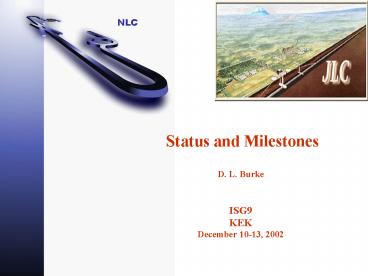Status and Milestones PowerPoint PPT Presentation
1 / 18
Title: Status and Milestones
1
Status and Milestones
- D. L. Burke
- ISG9
- KEK
- December 10-13, 2002
2
Mission and Strategy
- There is compelling reason to establish the
X-Band technology soon. - The international science community is taking on
a 20-year mission to understand particle physics
at the TeV energy scale. - The LHC and a linear collider must have periods
of concurrent operation to reinforce and guide
each other, just as the case has been in the
past. - Construction and commissioning of a linear
collider will take 8 years. - Making a choice of linac technologies will
enhance the probability that a linear collider is
built and ready in time to meet this mission. - We must accelerate the demonstration of an X-Band
rf system and we must do it with no increase in
level of funding.
3
8-Pack Phase-I
PPM Klystrons (75 MW 1.6 µsecs)
Power to loads in March 2003.
Dual-Mode SLED-II (4-fold compression in time,
factor 3.3 in power)
Single Feed RF Pulse (500 MW 400 nsec)
4
NLC/JLC(X) SLED-II Baseline
- Phase-I of the 8-Pack will demonstrate the
feasibility of a SLED-II rf system similar to
that presently in use at the NLCTA. - This demonstration will occur in 2003.
- JLC and NLC physicists presented to the world
community (ILC-TRC) a SLED-II Baseline Design for
an X-Band collider. - The R1s
- SLED-II Power Demonstration
- Structure Gradients
5
The Test Accelerator
The NLCTA with 1.8 m accelerator structures (ca
1997).
RF Power from SLAC
Demonstrated ability to reach 500 GeV cms.
Accelerating gradient of 25 MV/m (loaded) with
good wakefield control and energy spread.
Structures from KEK.
6
X-Band RF Systems
- NLCTA
- SLED-II System
- (1997)
- Conventional PFN modulator
- 50 MW/1.2?s solenoid-focused klystrons
- SLED-II pulse compression
- 1.8m DDS structures at 40 MV/m
- X-Band TeV
- SLED-II System
- (2002)
- Solid-state modulator
- 75 MW/1.6?s
- PPM-focused klystrons
- Dual mode SLED-II pulse compression
- 0.9m DDS structures at 65 MV/m
7
NLC/JLC SLED-II Baseline Test
NLCTA Housing
Dual-Mode SLED-II
Solid-State Modulator
Solenoid-Focused Klystrons (to be replaced with
PPM tubes).
8
SLED-II Demonstration Status
- Modulator is on-line and driving a pair of XL-4
klystrons. - Third XL-4 klystron being installed, and fourth
being conditioned in the Test Lab. - All SLED-II designs passed microwave cold
tests and components are in production. - ? On schedule for power tests to loads in March
2003.
Permanent magnet focused klystrons (one each from
KEK and SLAC) scheduled for test in February.
9
Dual-Mode SLED IILow-Power (Cold) Tests
First Reflection (TE02)
Input Pulse (TE01)
320 ns
Second Reflection (TE01)
10
RF Pulse Heating
T53VG3
Performance limited by pulse heating of coupler
matching irises.
Distribution of Breakdowns (70 MV/m, 400 ns, 10
hr run)
Autopsy performed after high-gradient testing.
Rate in cells ? .1/hr
Input coupler
Output coupler
58 Cells
Beams eye view of input coupler.
RF
RF
SEM picture of input matching iris. Pulse heating
in excess of 100 C.
11
Mode Conversion (MC) Coupler
Esmax 34 MV/m _at_ 48 MW Hsmax 98.4 kA/m _at_
48 MW ? Pulse Heating 3 C
WC90
WR90
RF
TM01 Mode Launcher
12
Operations of T53VG3MC (Mode Conversion
Couplers)
Unloaded Gradient (MV/m)
Time with RF On (hr)
13
High-Gradient RD Summary
- Test structures exceed the design goal of 65 MV/m
for the JLC/NLC TeV collider. - Remains to complete fabrication and test of
NLC/JLC-Ready structures with full detuning and
damping. - First tests of a/l 0.18 structures (with bad
couplers) look good, and testing of structures
(with good couplers) is starting. - Will start testing full-featured structures in
May to satisfy TRC R1 items. There is a
broadly-based line-up of structures in design and
fabrication at SLAC, KEK, Fermilab, and CERN. - ? Schedule.
14
X-Band Accelerator with Length for 500 GeV/Beam
32 km
3.5 km
Why X-Band?
Bypass Lines e.g. 50, 175, 250 GeV
Injector Systems for 1.5 TeV
15
NLC/JLC Energy Reach
25 Bunches
CMS Energy (GeV)
192 Bunches
Luminosity (1034)
The JLC/NLC Stage 2 design luminosity is 5 ? 1033
cm-2 s-1 at 1.3 TeV cms.
16
Energy Goals
- The energy reach of NLC/JLC is significantly
greater than that of TESLA (for comparable cost). - This will be the central issue in the choice of
technology. - HEPAP 2001 500 GeV expandable to
800-1000 GeV - ECFA 2001 400 GeV
- ACFA 2001 initial 300-500 GeV upgrade to
greater than 1 TeV. - The international community needs to reach a
consensus on the importance of access to the
highest energies.
17
ILC-TRC Interim ReportICFACERN, October 2002
- By the end of 2003, we hopefully should know if
TESLA can reach 800 GeV at 35 MV/m. - By the end of 2003, we hopefully should know if
JLC/NLC can meet its main linac TeV RF system
specifications. - If yes, then the International Community could
make a choice based on the other respective
merits of these machines.
18
NLC-JLC Collaboration
- Our job is to prepare for this technology choice.
- Complete the critical RD (TRC R1 and R2)
- Update and document the X-Band Baseline design.
- Understand site requirements and cost estimates.
- ? ISG9 will focus on this job.

